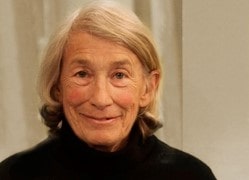Every Morning by Mary Oliver
“Every Morning” by Mary Oliver (1935-2019) was first published in Poetry magazine in March 1986. This poem is about an ordinary morning, where the poet reads the newspaper, which is filled with the horrors of war and death. For the speaker, death and destruction to this extent is a sort of happening that is detached from reality.
- Read the full text of “Every Morning” below:
Every Morning by Mary Oliver I read the papers, I unfold them and examine them in the sunlight. The way the red mortars, in photographs, arc down into the neighborhoods like stars, the way death combs everything into a gray rubble before the camera moves on. What dark part of my soul shivers: you don’t want to know more about this. And then: you don’t know anything unless you do. How the sleepers wake and run to the cellars, how the children scream, their tongues trying to swim away— how the morning itself appears like a slow white rose while the figures climb over the bubbled thresholds, move among the smashed cars, the streets where the clanging ambulances won’t stop all day—death and death, messy death— death as history, death as a habit— how sometimes the camera pauses while a family counts itself, and all of them are alive, their mouths dry caves of wordlessness in the smudged moons of their faces, a craziness we have so far no name for— all this I read in the papers, in the sunlight, I read with my cold, sharp eyes. - from Poetry (March 1986)

Summary
In “Every Morning,” Oliver’s speaker reads the news about the calamities of war, how it affects families, children and causes the death of many people. Oliver paints a hauntingly vivid picture of the aftermath of war, red mortars firing shells down like meteors, and how people awakened by the sounds run to find refuge somewhere. Not only that, children are screaming in utter terror. People are hiding behind smashed cars and moving along them to dodge the bullet. The sirens of ambulances are being heard constantly, and families are counting heads to ensure that how many of them are still alive. Oliver calls this a craziness humankind does not have a name for. Furthermore, she paints a juxtaposed image of the sufferings of war being witnessed (or read) from the comfort of the speaker’s home.
Meaning
Oliver’s poem “Every Morning” shows how the violence of war rips apart at every inch of humankind. The brutalities that come with a war scar the families and children for a lifetime. Virtually, it is a hopeless situation where the bystanders watch the brutal happenings with sympathy, grief, and indifference. The speaker of the poem is particularly detaching herself from the news. She treats it as scenes out of fiction. The speaker determines the setting of the home perfectly as a comfortable and safe place. It has been shattered for the people who fell victim to the war.
The poem as a whole reflects a larger issue in the world — ignorance and selective indifference. Bystanders have a choice to make — to either take action or to watch by the sidelines. At times of war, there is usually no way a bystander can help. Thus, fear, sympathy, and ignorance are the main emotions conveyed through this poem.
Structure & Form
Oliver’s “Every Morning” is written in free-verse since it does not contain any metrical pattern or rhyme scheme. It does not follow any traditional rules of poetry. The text follows the rhythm of natural speech as the tone is narrative and flows easily. There are a total of 29 lines that are grouped into a single stanza. The lines are intricately connected, which creates a suspenseful and tense mood in the text. Readers wait for what is going to happen next. Besides, the poem is told from the perspective of a first-person speaker. It gives this piece an outlook of lyric poetry.
Poetic Devices
In “Every Morning,” Oliver uses the following poetic devices:
- Alliteration: It occurs when similar sounds are repeated in neighboring words. For example, Oliver uses the repetition of the harsh “d” sound “stop all day—death and death, messy death—/ death.”
- Juxtaposition: Use of contrasting imagery to create an antithetical image. For example, “how the children scream, their tongues/ trying to swim away—/ how the morning itself appears/ like a slow white rose,” “in the sunlight,/ I read with my cold, sharp eyes,” etc.
- Metaphor: The comparison of two ideas that are not to be taken in a literal sense. For example, “the way death/ combs everything into a gray rubble,” “their mouths dry caves of wordlessness,” “smudged moons of their faces,” etc.
- Enjambment: Oliver uses enjambment to maintain a steady flow. For example, it occurs in “like stars, the way death/ combs everything into a gray rubble before/ the camera moves on.”
- Simile: It occurs in “The way the red mortars, in photographs,/ arc down into the neighborhoods/ like stars,” and “how the morning itself appears/ like a slow white rose.”
- Personification: Assigning human characteristics to non-living things is personification. For example, it is used in the following lines, “the way death/ combs everything into a gray rubble before/ the camera moves on,” “What/ dark part of my soul/shivers,” “how the morning itself appears,” “their tongues/ trying to swim away—” etc.
Line-by-Line Analysis & Explanation
Lines 1-7
I read the papers,
I unfold them and examine them in the sunlight.
The way the red mortars, in photographs,
arc down into the neighborhoods
like stars, the way death
combs everything into a gray rubble before
the camera moves on. What
The poem “Every Morning” begins with a description of the setting — a sunlit morning at home where a speaker reads and examines the newspaper. Oliver builds the tension by using the term “red mortars.” Here, “red” signifies anger and bloodshed, as in the photographs in the newspaper. The speaker describes the bullets as stars falling from the sky — terrifying imagery!
Furthermore, she observes how death paints everything into “a gray rubble” — dismal and absurd — before the camera moves on. These lines hint at how even those who took these pictures had been standing by and silently watching a tragedy unravel.
Lines 8-14
dark part of my soul
shivers: you don’t want to know more
about this. And then: you don’t know anything
unless you do. How the sleepers
wake and run to the cellars,
how the children scream, their tongues
trying to swim away—
The poet continues by saying that a part of the speaker’s soul shivers in fear and unease. A voice in her head says that she does not want to know any more of the tragedies that surround her. However, according to the poet, the truth is that if a person does not know the reality of the world, they remain truly ignorant. After this introspection, the poet goes back to describing the images. She describes how likely people abiding on the streets wake up to the sound of bullets being fired. They run in absolute terror to find refuge somewhere safe. The children scream and wail as if this would help them or that they could escape this horror altogether.
Lines 15-21
how the morning itself appears
like a slow white rose
while the figures climb over the bubbled thresholds,
move among the smashed cars, the streets
where the clanging ambulances won’t
stop all day—death and death, messy death—
death as history, death as a habit—
After the heartbreaking image of a child’s wailing, Oliver goes on to say that despite all of this, the morning will come again, and the sun will rise slowly like “a white rose,” which symbolizes hope and peace. However, at the same time, she describes how some people are still on the move to escape the line of fire. They climb over broken thresholds and move from one smashed car to another while the ambulances keep coming to those same streets.
The speaker finds no other words than to describe the scene by repeating the term “death.” She calls death “messy” compares it with human “history” and a “habit.” It refers to how time and time again, people killed one another during the war — so much so that Oliver calls it “history” and “habit.”
Lines 22-29
how sometimes the camera pauses while a family
counts itself, and all of them are alive,
their mouths dry caves of wordlessness
in the smudged moons of their faces,
a craziness we have so far no name for—
all this I read in the papers,
in the sunlight,
I read with my cold, sharp eyes.
In the last few lines of “Every Morning,” the speaker talks about the “camera” through which she witnesses the scene. She notices a family that counts itself to make sure that everyone is alive. It is a haunting moment for them. Their throats are parched of any words, and their faces are pale like “the smudged moon” for the horrors of war. The speaker calls this a “craziness” humanity does not have a name for.
Oliver ends the poem the same way it started, by saying that the speaker reads a newspaper in the sunlight. The term “cold” shows her indifference. Her “sharp eyes” do not fail to notice the minute details of humanity’s darkest side.
Themes
Horrors of War
Throughout “Every Morning,” it is seen that the poet is a spectator, reading the newspaper and picturing the ground reports of war. In some ways, she seems to detach herself from the scene and picture it as if it were fiction; for example, “the way death/ combs everything into a gray rubble before/ the camera moves on.” Here, the narrator hints at looking at war scenes as if it is a movie or something out of fiction. She manages to remain sympathetic towards the victims while painting the picture. The irony is that she does so from the comfort of her home. Besides, Oliver draws upon all the five senses using descriptive language to shed light on the brutalities of war.
Human Suffering and Indifference
The speaker’s tone is sympathetic at the same time, indifferent. This shows the exact emotions of most bystanders during a war. The speaker talks about how her soul shivers with fear, and it craves ignorance. It also knows that not knowing is to be worse off.
Symbolism
Symbolism is the use of words to represent a number of ideas. Oliver says that the morning appears like a “slow white rose.” Here, the “white rose” symbolizes hope, love, and respect. All of the ideas are the opposite of war.
Furthermore, in the phrase, “the smudged moons of their faces,” the “moon” acts as a symbol. For centuries, it has been known to represent the rhythm of time and eternity. Here, the “smudged” moon shows how the rhythm of time has been disrupted for the family who became victims of the war.
Historical Context
Mary Oliver was an American poet and the winner of the National Book Award and the Pulitzer Prize. One of Oliver’s best-known poems, “Every Morning” is about the calamities of war and how it is like to be a bystander during those times. It was written in response to the wars happening around the later half of the 20th century. This piece was first published in the March 1986 issue of Poetry magazine. It recounts the aftermath of war from the clippings of newspaper articles.
Questions & Answers
The central idea of one of Oliver’s best-known poems, “Every Morning” is being a bystander during times of war and watching the brutalities unravel before one’s eyes.
Mary Oliver compares death to history and habit because time and time again, people ruthlessly butchered one another. It resulted in the loss of millions of lives.
Here, Oliver talks about the feeling of unease that creeps up when a person reads the news about the war. A part of their subconscious mind does not want to know about the horrors that exist in reality. However, Oliver thinks that reverting one’s eyes is a gesture of conscious ignorance.
The poem is written in free-verse. It means there is no specific rhyme scheme or meter. The text consists of a total of 29 lines that are grouped into a single stanza.
The poetic devices used in the poem are imagery, metaphor, alliteration, simile, etc.
Similar Poems about Death and War
- “Dreamers” by Siegfried Sassoon — This anti-war poem protects the theme of perception vs. reality.
- “Death the Leveller” by James Shirley — In this poem, Shirley describes the egalitarian nature of death.
- “Everyone Sang” by Siegfried Sassoon — This poem recounts people’s experience on the armistice.
- “The child who was shot dead by soldiers at Nyanga” by Ingrid Jonker — This piece is written in protest of the killing of a child during the apartheid era.
External Resources
- Check out A Mary Oliver Collection — Explore this collection of Mary Oliver poems, which contains all the poems from her recent books of poetry.
- March 1986 issue of Poetry — Explore some other poems published in the March 1986 issue of the magazine.
- History of the 1980s — Read about the significant wars that occurred in the ‘80s.
- Biography of Mary Oliver — Learn about the poet’s life and works.
- Poet Profile & Poems of Mary Oliver — Read more about the poet and her poems.




